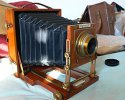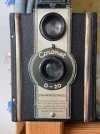-
Welcome to this forum . We are a worldwide group with a common interest in Birmingham and its history. While here, please follow a few simple rules. We ask that you respect other members, thank those who have helped you and please keep your contributions on-topic with the thread.
We do hope you enjoy your visit. BHF Admin Team -
HI folks the server that hosts the site completely died including the Hdd's and backups.
Luckily i create an offsite backup once a week! this has now been restored so we have lost a few days posts.
im still fixing things at the moment so bear with me and im still working on all images 90% are fine the others im working on now
we are now using a backup solution
You are using an out of date browser. It may not display this or other websites correctly.
You should upgrade or use an alternative browser.
You should upgrade or use an alternative browser.
Birmingham Camera Companies
- Thread starter toolate4regrets
- Start date
-
- Tags
- cameras industry photography
Stokkie
master brummie
My Dad worked for Coronet Camera pre-war, but the company let him go in a slump. He also worked making clockwork film projectors. He ended up as a foreman at Chamberlain and Hookham, precision engineers. Coronet had tried to re-engage him, but he had moved on. I have a few of the cheap Coronet cameras as keepsakes but sadly none of the cult collectable Midget cameras (price depends on colour). Given that they were given away as a free gift with breakfast cereal and the optical quality was poor, it is remarkable that they fetch £400 for some models. They are cute and you could put a complete collection in a row, but my head has always ruled my heart. Coronet had an associated works which did the plastic injection moulding.
Brummie a long time ago
master brummie
Was that the 'Noddy Bike' that Mr Plod rode in the 'old days' ?Velocette, one of the great names in British motorcycling had their factory in York Road.
Andrew.
Stokkie
master brummie
Thanks Mikejee. Corrected.Stokkie
I get message "Cannot be found" for image
Richard Dye
master brummie
My parents bought me a Conway box camera in about 1955 or 6 made without close up. You could take pictures vertically or horizontally and used 120 film. And no I did not keep it.Here's my Coronet D20 made in the 1930s. Box camera for roll film with waist level finder, close up lens and a filter for bright sunny days. My father in law bought me this a few years ago as a sentimental gift. Made of fibreboard and tinplate.
View attachment 170802
Stokkie
master brummie
My father didn't keep any Coronet cameras either! I know that quality optics and cameras have been made in the Midlands, but these are cheap and cheerful. He did keep his Box Brownie.My parents bought me a Conway box camera in about 1955 or 6 made without close up. You could take pictures vertically or horizontally and used 120 film. And no I did not keep it.
Pete, was that camera olympic or olympus?i had a aldis slide projector. that i used after making slides,..... bulk out of date 35m film was very cheap.my camera was a olympic bought from a shop in cannon st
Stokkie
master brummie
These 120 mm roll film cameras are still usable, if you can get one without pin holes in the bellows. Lancaster earlier made quality view cameras. The negative is a glass plate and you focus the image on a screen with a black cloth over your head. On a tripod naturally. But you can achieve amazing quality. The image on the ground glass screen is upside down, but for landscapes or portraits this isn't a problem.
Viv's camera is much more portable. I used a Coronet Record Rapide as a teenager, which is a similar design, but inferior quality. Naturally there were light leaks and I moved to better cameras. These days smart new red bellows can be purchased to keep these old cameras going. {Picture Justin Cormac, https://creativecommons.org/licenses/by-sa/2.0/deed.en}

Viv's camera is much more portable. I used a Coronet Record Rapide as a teenager, which is a similar design, but inferior quality. Naturally there were light leaks and I moved to better cameras. These days smart new red bellows can be purchased to keep these old cameras going. {Picture Justin Cormac, https://creativecommons.org/licenses/by-sa/2.0/deed.en}

Brummie a long time ago
master brummie
Plus, the benefit of viewing angle correction by tipping the lens relative to the plate. Try that with a standard film camera. It would be a darkroom excercise.The image on the ground glass screen is upside down, but for landscapes or portraits this isn't a problem.
What would be the reaction these days to wandering around with a black cloth over your head holding an iPhone to your face ?
Andrew.
Could come in useful given the reflections on the highly glossy surface of an iPhone ! Viv.
Richard Dye
master brummie
Andrew,Plus, the benefit of viewing angle correction by tipping the lens relative to the plate. Try that with a standard film camera. It would be a darkroom excercise.
What would be the reaction these days to wandering around with a black cloth over your head holding an iPhone to your face ?
Andrew.
You just might start a new fad, you just never know these days
Stokkie
master brummie
Tilt and shift are very handy in photographing buildings. Nikon and Canon make special, expensive lenses for digital cameras. Fuji had a film camera with shift. There are a few artists and enthusiasts using view cameras. Replace the glass plate holder in the Lancaster with a modern dark slide and you are away!Plus, the benefit of viewing angle correction by tipping the lens relative to the plate. Try that with a standard film camera. It would be a darkroom excercise.
What would be the reaction these days to wandering around with a black cloth over your head holding an iPhone to your face ?
Andrew.
Stokkie
master brummie
A view camera with cloth is ideal for a special project which might enable you to take pictures in a place where the locals are not keen in having a modern camera in their face. The formal ritual and time setting up makes for interest. I've seen tintypes done this way and developed in a portable studio.Andrew,
You just might start a new fad, you just never know these days!
Stokkie
master brummie
Lancaster traded as an optics company from 1835 (the dawn of photography) until 1955. Quite a record. https://en.wikipedia.org/wiki/J._Lancaster_&_Son
The centre of camera production shifted to Germany before the war and Japan after then.
The centre of camera production shifted to Germany before the war and Japan after then.



